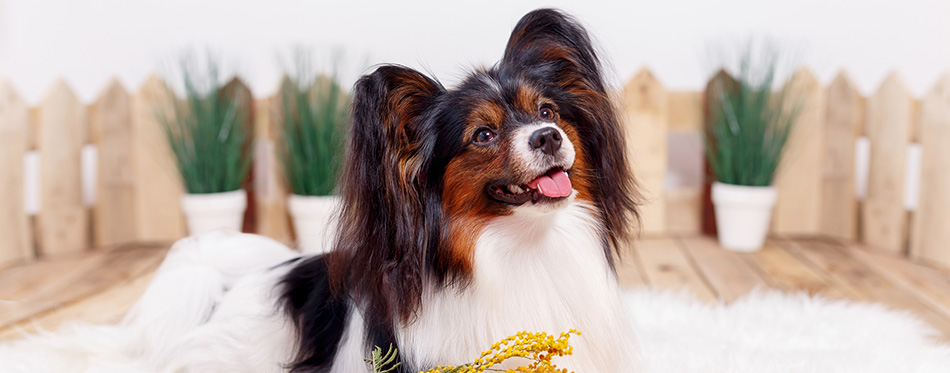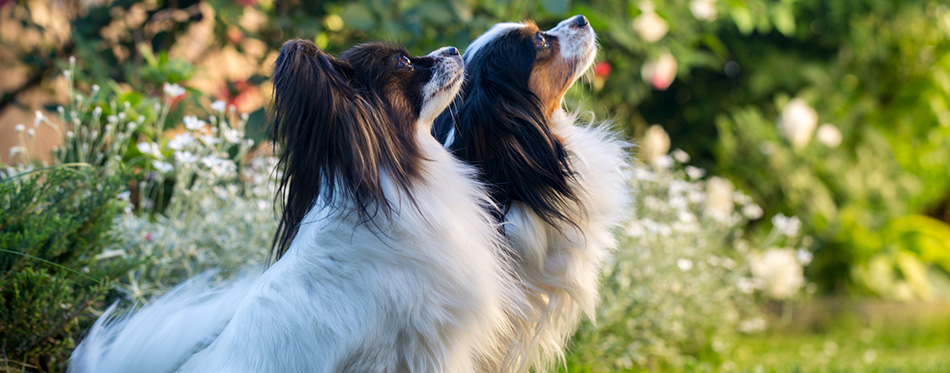Descending from toy spaniels, this adorable little dog can be traced back hundreds of years. Today, they are friendly and fun-loving dogs who make great companions. But they are not just all about the beauty. These are also athletic pooches who do well in activities such as agility training. And for those who are willing to put in the time and effort, you can teach them to do all sorts of tricks. They can do well in climates both warm and cool, which make them a popular dog all over the US. And they simply love their families and being around humans.
Whether you are looking to adopt one of these little pooches yourself or you simply wish to find out more about the breed, here is a detailed guide offering a host of this information. Starting with the history…
History of the Papillon
We can see examples of the Papillon dog breed in paintings way back in the 16th century by some of the most famous artists of the era. They were a favorite amongst court ladies throughout European countries including Spain, France, and Italy. During the Renaissance era, existing toy breeds were crossed with spaniels to creates miniature versions of the popular dog, which was a popular trend at the time.
Originally, their ears were droopy, but this changed when a small spaniel with upright ears was developed by Louis XIV and given the nickname ‘papillon’ after their resemblance to a butterfly. The other main change from the first dogs is the fact that they used to be solid-colored but now they are white with patches of color. While the breed’s connection to France is strong, the breeding centers of Spain and Italy have a lot to do with popularizing the pooch. It was 1915 when the American Kennel Club first registered the breed. In 1999, a Papillon made history by being named the Best in Show at the Westminster Kennel Club.

Quick Facts About the Papillon
- Papillons range between 8 and 11 inches in height, weighing between 4 and 9 pounds.
- The lifespan of Papillons is relatively long – they can live well into their teens.
- What does a Papillon dog look like? They are known for their long, flowing coats, which are fine in texture and silky to the touch. Papillon is French for butterfly, and their name comes from their butterfly-like ears.
- Other names by which the Papillon dog breed has been known over the years include Epagneul Nain (dwarf spaniel), Dwarf Continental Spaniels, Belgian Toy Spaniels and even Little Squirrel Dogs due to the resemblance of their tail to those of squirrels.
- Some of the most famous admirers of these dogs include Madame de Pompadour, Louis XIV, and Marie Antoinette.
- The Papillon was painted by renowned artists including Rubens, Rembrandt, Goya, and Toulouse-Lautrec.
Things You Should Know
There is plenty that you need to know about bringing a Papillion into your life. You need to ensure that you are ready to meet their various needs, many of which are detailed below.
Health
As Papillon pups are such small dogs, you need to be especially careful with them – particularly when they are puppies. A few potential hazards include larger animals, furniture, and stairs. While they can get on well with children, small kids can be too rough with their pets. A few common conditions that should be screened for by responsible breeders include a fontanel in the top of the skull, patellar luxation, slipping or dislocating kneecaps, and a collapsed trachea. A few tests that have been recommended for this breed include a cardiac exam, patella evaluation, and ophthalmologist evaluation.
Another common condition in toy puppies is hypoglycemia, which can be treated in its early stages but is potentially fatal if not. You need to recognize some of the common signs and symptoms of this condition. Firstly, you may notice your dog slowing down and showing signs of lethargy, before shivering or trembling. You can combat the effects by placing honey under their tongue and taking them to the vet immediately. This is a serious situation that can lead to a coma and death, so it is not to be ignored. It often occurs when toy puppies do not have the fat reserves to supply glucose in stressful times or when they don’t eat regularly enough.
Papillions are sensitive to anesthesia, so you need to be aware of this before electing any surgical procedures.
Training
When you are training your butterfly eared dog, it is best to use positive reinforcement techniques such as a rewards-based system coupled with plenty of praise. You will find that they will respond a lot better than with negative behavior like yelling.
Housetraining should be relatively straightforward if you keep them on a tight schedule. You should get into a habit of taking them out when they first wake up, after every meal, naps, playtime, grooming sessions, and before they go to bed. When you aren’t on hand to supervise your dog, you can put them in a puppy-proofed room.
Crate training is highly useful in preventing little accidents inside your home, but it also provides a place where your dog can retreat from the world or take a nap. However, you shouldn’t put them in for more than a few hours at once except at nighttime. These are dogs that love being around people and don’t appreciate being isolated for extended periods of time.
Exercise
This is not the type of dog that is used to living outside, but they are active and will enjoy bounding around a fenced-in yard. If you live in an apartment, you can still expect them to tear around your house athletically. You need to be careful when they are puppies as their bodies are more fragile and they could easily break a bone if they fly down from up high. These are active dogs who you can need at least a couple of 20-30-minute exercise sessions every day. When they are puppies, these can start at around 10 or 15 minutes before being increased. You should notice when your dog gets tired as they will stop and sit down.
As these are such curious and active dogs, you need to be prepared to offer them plenty of mental stimulation, as well as regular physical workouts. You can do this by providing them with regular training activities, as well as investing in some puzzle toys that engage them. You can also teach them plenty of new tricks and even do more complex activities like agility training. Head over to our review of dog agility tunnels for more alternatives.

Nutrition
As Papillons are small dogs, you shouldn’t have to feed them too much. Remember, if you offer a better-quality food, you shouldn’t have to feed as much to your dog as they will get more of the nutrients they need. Whatever diet you choose, it should be appropriate to their age, size, activity levels, and metabolism speed. As these are small dogs, it doesn’t take much for them to get overweight. While treats can be a useful training aid, you shouldn’t offer too many high-calorie snacks as these can easily contribute to obesity. And this can be a particular problem in Papillon dogs as they have delicate knees. Make sure that you put plenty of fresh water down – especially if your pooch is on a dry food diet or the weather is particularly warm. If you give them set meals rather than free feeding, this helps you to keep track of how much they are consuming on a regular basis.
Grooming
While their hair is long and silky, you don’t need to groom your dog too frequently. A lot of this is down to the fact that they don’t have an undercoat. If you give them a proper grooming session every month and a few brushes on a more frequent basis, this should be fine. Concentrate on the areas where mats are more likely to form such as behind the hind legs and behind the ears. You should only need to give them a bath every few months or when they get particularly muddy or dirty. Their nails are known for growing quickly, so these should be trimmed on a regular basis. Pay attention to the dewclaw which can curl around and piece the leg. Regular tooth brushing is important in maintaining dental health. You should get into the habit of brushing your dog’s teeth from a young age. This way, they are more likely to get used to the procedure sooner rather than later. Two or three times a week is a good amount to aim at, but if you can clean your dog’s teeth on a daily basis, this is the best way to keep them clean and free of tartar.
Dog grooming guides that you might like: dog bathtub, dog dryer, dog paw washer, dog wipes, dog toothpaste and dog toothbrush.
Temperament
While you may think that this a lap dog, they are much more curious and adventurous creatures than this. If you don’t provide enough for your pup to do, it is more likely that they are going to try and find their own source of entertainment. And despite their small size, they are happy hunters of smaller creatures, so you should keep yours on a leash when you are out and about. If you let them out in the back yard, you should make sure that they are properly fenced in.
When your dog is firmly settled into the family, they will be your constant companion as well as your faithful watchdog. They are highly alert creatures, but they may forget their little size, so you need to ensure they don’t confront too many larger animals who could do them some harm. These dogs are highly outgoing and love being around people, so you need to make sure that you give your pooch plenty of love and attention.
You need to be aware that Papillions have high energy levels, so you need to be ready to give your dog the physical exercise they require. There are several ways that you can manage their intense requirements, and one of the best is to enroll them in agility or rally training. They also do very well in obedience training. In fact, they are the number one ranked toy breed. You can also enroll them in basic training activities, and they do well in these classes as they have a strong desire to please their masters.
Papillions can get along with children and other animals – even cats. You may find that your little dog is so bossy that they get the better of larger hounds! You need to be wary of children around your little pooch – both are at risk of injury if your dog is not handled correctly. So, you should always teach your kids the best way to play with your pup and supervise them if necessary.

Final Thoughts
There are plenty of reasons why Papillion dogs are so popular. Not only are they adorable, but they are faithful companions. They can adapt to a range of living situations and can get on with children and other animals as long as they are socialized at a young age. As these are pooches with long lifespans, you need to know about the commitment that you are making.
If you are getting one from a breeder, you need to know that you are probably going to have to be put on a waiting list. You should ask to meet one or more of the parents before bringing your puppy home. Some of them are known to be especially nervous or high strung. As people sometimes get one of these dogs without knowing the amount of work that is required, there may be some in need of fostering or adoption.
Another point to be aware of is that this is a very social dog, so you need to be prepared to give them plenty of love and attention. Also, they have high energy levels, so you need to give them enough exercise and mental stimulation.

